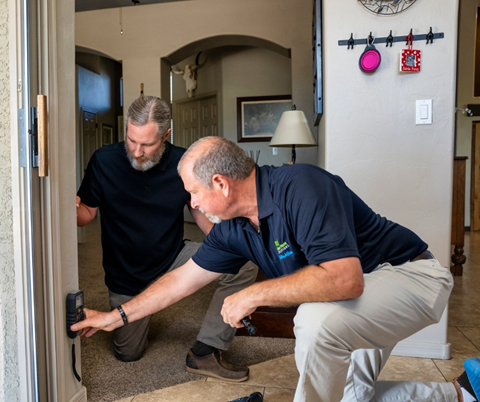The Need of Mycotoxin Examining in Agricultural Products to Ensure Customer Security
The requirement of mycotoxin testing in agricultural products is an important element of public health and wellness and safety and security that calls for complete assessment. Mycotoxins, hazardous compounds generated by specific fungi, can penetrate numerous crops, causing considerable wellness dangers for consumers, such as carcinogenic results and body organ damage. Normal mycotoxin testing not just removes and determines contaminated items from the supply chain however also makes certain compliance with security standards and improves customer depend on. However, understanding the approaches and benefits of such screening is necessary to completely appreciate its importance in safeguarding our food supply.
Understanding Mycotoxins
Mycotoxins, harmful additional metabolites created by particular fungis, present a considerable risk to farming products and human health. These compounds are produced by different types of mold and mildews, such as Aspergillus, Fusarium, and Penicillium, which can infect plants both pre- and post-harvest - Mycotoxin testing Services. One of the most usual mycotoxins consist of aflatoxins, ochratoxin A, fumonisins, zearalenone, and deoxynivalenol (DON)
Mycotoxin contamination can happen under specific ecological problems, such as high moisture and temperature, which favor the growth of mold and mildew. Agricultural products like grains, nuts, flavors, dried out fruits, and coffee are especially vulnerable. The existence of mycotoxins in these products can result in substantial financial losses as a result of minimized plant returns and the necessity for extensive testing and purification procedures.
Comprehending the biochemical nature and formation of mycotoxins is essential for establishing effective reduction approaches. Research has actually shown that mycotoxins exhibit an array of chemical structures and properties, making discovery and removal difficult. Advanced analytical strategies, consisting of chromatography and mass spectrometry, are used to identify and measure mycotoxins in agricultural items, making certain that contamination levels remain within risk-free limits developed by regulative bodies.
Health And Wellness Risks of Mycotoxins
Given the significant dangers associated with mycotoxins in farming items, recognizing their influence on health is paramount. Mycotoxins, poisonous second metabolites created by fungis, position extreme risks to both animal and human health and wellness.
Severe mycotoxin poisoning, although less typical, can create severe and immediate illness such as liver damages, gastrointestinal disruptions, and hemorrhaging. Ochratoxin A, an additional potent mycotoxin, is linked to kidney damages and has potential carcinogenic effects. Fumonisins, mostly affecting maize, are linked with esophageal cancer cells and neural tube defects.

Usual Sources of Contamination
Understanding the typical resources of contamination is critical for properly taking care of and alleviating the threats positioned by mycotoxins. Mycotoxins are hazardous additional metabolites created by specific sorts of fungis, which can contaminate farming items at numerous phases of processing, production, and storage space. The key resources of contamination include field problems, post-harvest handling, and storage atmospheres.
Area conditions play a significant duty, with elements like climate, plant susceptibility, and soil wellness affecting fungal development. Crops such as corn, peanuts, wheat, and tree nuts are especially at risk to mycotoxin-producing fungi like Aspergillus, Fusarium, and Penicillium varieties. Insufficient crop turning and poor bug monitoring can aggravate the danger of contamination.
Post-harvest handling is another important phase where contamination can take place. Mechanical damages throughout harvesting and transport produces entrance points for fungis, while improper drying strategies can leave wetness levels high enough to support fungal growth.
Storage space atmospheres contribute significantly to contamination risks. Poorly preserved storage space centers with high humidity and temperature levels produce suitable problems for mycotoxin manufacturing. Regular inspections and correct storage space problems are essential in suppressing this threat.
Mycotoxin Checking Techniques
Effective administration of mycotoxin contamination hinges not only on recognizing potential resources but likewise on executing robust screening approaches to identify these dangerous compounds. Mycotoxin testing approaches can be extensively classified right into immunochemical and chromatographic methods.
On the various additional reading other hand, enzyme-linked immunosorbent assay (ELISA) and side flow assays are famous immunochemical methods. ELISA, particularly, is widely made use of due to its cost-effectiveness, simplicity of usage, and fast turn-around time. Lateral flow assays supply fast, on-site testing capabilities, making them suitable for area applications where immediate decisions are required.
Additionally, advancements in molecular biology have introduced PCR-based methods with the ability of discovering mycotoxin-producing fungis at hereditary levels, supplying a predictive method to contamination threat. Integrating these diverse techniques improves the integrity and comprehensiveness of mycotoxin discovery, making sure that agricultural products satisfy security criteria and safeguarding customers from possible wellness dangers.
Benefits of Normal Checking

Routine mycotoxin screening offers substantial benefits that dramatically bolster farming security and quality. Mycotoxins, hazardous substances generated by specific fungis, can pollute food and position severe health and wellness threats, consisting of cancer and acute poisoning.
In addition, constant screening helps in keeping the stability and credibility of farming producers. By rigorously managing and checking mycotoxin levels, producers can prevent pricey recalls and legal effects. This not only guarantees conformity with stringent worldwide safety and security standards but also fosters consumer count on and commitment.

Conclusion
The requirement of mycotoxin testing in agricultural items is highlighted by the considerable health and wellness risks presented by these hazardous compounds. It enhances the reputation of manufacturers and cultivates count on within the agricultural supply chain, inevitably guarding public health and wellness.
The necessity of mycotoxin screening in agricultural products is a vital aspect of public wellness and security that warrants comprehensive exam. Mycotoxins, hazardous compounds generated by specific fungis, can infiltrate various plants, leading to significant health threats for consumers, such as carcinogenic effects and body organ damage.Mycotoxins, poisonous additional metabolites generated by specific fungi, offer a substantial risk to farming products and human health and wellness.Offered the considerable risks connected with mycotoxins in farming products, recognizing their effect on health and wellness is paramount (Mycotoxin more testing Services).The requirement of mycotoxin his response testing in agricultural items is underscored by the considerable health and wellness risks postured by these harmful substances